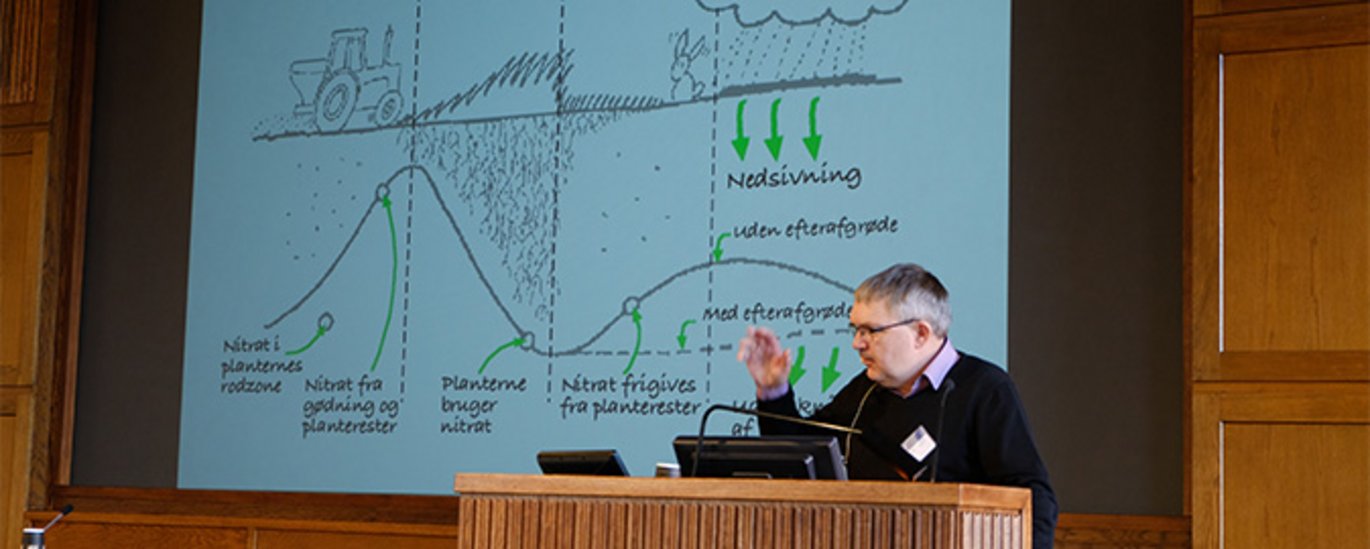Aarhus University organises open workshop on the calculation model used in the Agricultural Package
Following the intense debate in relation to Aarhus University’s NLES4 model for nitrogen leaching, the university organised an open workshop with presentations from Aarhus University, University of Copenhagen, the Danish society for Nature Conservation and SEGES. The presentations gave rise to an animated debate.

The recent debate on the scientific foundation behind the Agricultural Package began in November 2017, when Bjørn Molt Petersen criticised Aarhus University’s calculation model NLES4 in the newspaper Berlingske. On 1 March, the university organised a workshop allowing for an elaborate scientific discussion of the problems with agricultural nitrogen leaching.
- Obviously, our policy advice may have played a part in the political evaluation of whether targeted regulation was an environmentally negotiable road ahead. Therefore, it is only fair that nature conservation societies and other parties pose critical questions to our efforts and criticize the applied models. We take this seriously, and consequently invited you to this workshop to allow critics to voice their concerns and present alternatives; and in addition, to discuss this issue openly with researchers from Aarhus University, says Director Niels Halberg, DCA – Danish Centre for Food and Agriculture at Aarhus University. DCA organised the workshop.
Researchers presented models
NLES is a model used to estimate nitrogen leaching from Danish arable land. The figures included in the model are based on actual measurements (over many years) of leaching from many different fields and experimental plots. NLES4 is the recent version of the model and constitutes the basis for parts of the government’s agricultural package.
- We also took the opportunity to provide a more comprehensive explanation of our models and the use of these than was covered in the media so far, including a description of how the much-criticised “marginal leaching” is calculated, says Niels Halberg.
New model in the pipeline
At the workshop researchers from Aarhus University presented measurements carried out to improve the NLES models; these demonstrated how nitrate leaching depends on nitrogen supply as well as a number of other conditions.
The researchers at Aarhus University maintain that the nitrate leaching estimate generated by the NLES4 model remains the most accurate measurement of how nitrate leaching changes according to changes in fertiliser application.
The researchers are currently developing a new version of the model, NLES5. In his presentation, Professor Jørgen E. Olesen, Department of Agroecology at Aarhus University, and one of the researchers behind the NLES model, addressed the criticism expressed by Bjørn Molt Petersen that NLES4 does not include uncertainty calculations. He informed the audience that NLES5 comprises such uncertainty calculations.
Different model types
At the workshop, researchers from the University of Copenhagen presented their model for nitrogen leaching, known as “Daisy”. Daisy is a mechanistic model in cointrast to the empiric NLES model, which is based on data from national nitrogen leaching measurements.
- We need an increased data basis when working with the NLES model. However, I anticipate that we will make good use of an increased integration of mechanistic models in the future, says Professor Jørgen E. Olesen, Department of Agroecology at Aarhus University.
Debate helps eliminate misunderstandings
In his presentation, Bjørn Molt Petersen expressed his criticism of the NLES4 model, as previously expressed in a report prepared for the Danish Society for Nature Conservation. Subsequently, he participated in a panel debate with Professor Jørgen E. Olesen and Senior Advisor Gitte Blicher-Mathiesen from Aarhus University as well as Professor Lars Stoumann Jensen, University of Copenhagen, and Chief Consultant Leif Knudsen, SEGES. The panel answered questions from researchers, industrial associations and political organisations.
- I am pleased that we have discussed scientific results and evaluations as well as different input today. Hopefully, a workshop like this may help eliminate scientific misunderstandings and result in a common understanding of the issues, says Jørgen E. Olesen
The workshop was live-streamed and the presentations are available below.
Presentations (in Danish)
Nitrogen circulation and marginal leaching. Gitte Blicher-Mathiesen, Department of Bioscience, AU
How to calculate nitrogen leaching. Jørgen E. Olesen, Department of Agroecology, AU
Nordic Field Trials. Kristoffer Piil, SEGES
Long-term crop rotation trials. Jørgen E. Olesen, Department of Agroecology, AU
Models and reality. Bjørn Molt Petersen, BMP Analytics
Impact of cultivation on marginal leaching, short and long-term perspective. Leif Knudsen, SEGES
